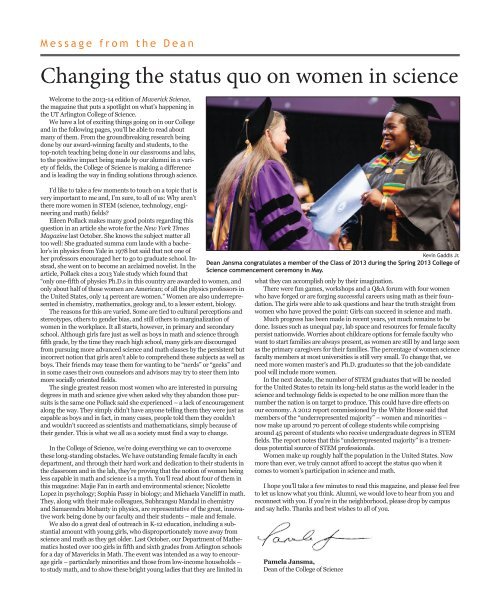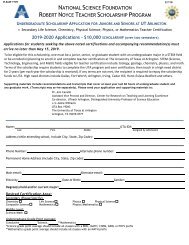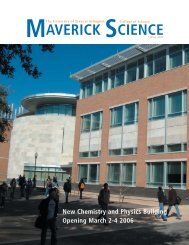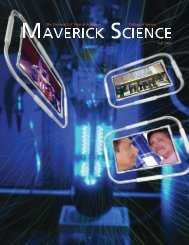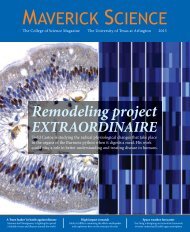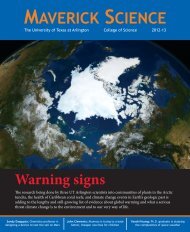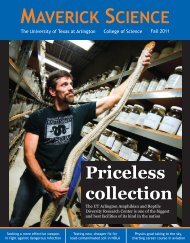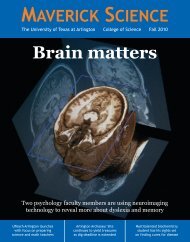Maverick Science mag 2013-14
You also want an ePaper? Increase the reach of your titles
YUMPU automatically turns print PDFs into web optimized ePapers that Google loves.
M e s s a g e f r o m t h e D e a n<br />
Changing the status quo on women in science<br />
Welcome to the <strong>2013</strong>-<strong>14</strong> edition of <strong>Maverick</strong> <strong>Science</strong>,<br />
the <strong>mag</strong>azine that puts a spotlight on what’s happening in<br />
the UT Arlington College of <strong>Science</strong>.<br />
We have a lot of exciting things going on in our College<br />
and in the following pages, you’ll be able to read about<br />
many of them. From the groundbreaking research being<br />
done by our award-winning faculty and students, to the<br />
top-notch teaching being done in our classrooms and labs,<br />
to the positive impact being made by our alumni in a variety<br />
of fields, the College of <strong>Science</strong> is making a difference<br />
and is leading the way in finding solutions through science.<br />
I’d like to take a few moments to touch on a topic that is<br />
very important to me and, I’m sure, to all of us: Why aren’t<br />
there more women in STEM (science, technology, engineering<br />
and math) fields?<br />
Eileen Pollack makes many good points regarding this<br />
question in an article she wrote for the New York Times<br />
Magazine last October. She knows the subject matter all<br />
too well: She graduated summa cum laude with a bachelor’s<br />
in physics from Yale in 1978 but said that not one of<br />
her professors encouraged her to go to graduate school. Instead,<br />
she went on to become an acclaimed novelist. In the<br />
article, Pollack cites a <strong>2013</strong> Yale study which found that<br />
“only one-fifth of physics Ph.D.s in this country are awarded to women, and<br />
only about half of those women are American; of all the physics professors in<br />
the United States, only <strong>14</strong> percent are women.” Women are also underrepresented<br />
in chemistry, mathematics, geology and, to a lesser extent, biology.<br />
The reasons for this are varied. Some are tied to cultural perceptions and<br />
stereotypes, others to gender bias, and still others to marginalization of<br />
women in the workplace. It all starts, however, in primary and secondary<br />
school. Although girls fare just as well as boys in math and science through<br />
fifth grade, by the time they reach high school, many girls are discouraged<br />
from pursuing more advanced science and math classes by the persistent but<br />
incorrect notion that girls aren’t able to comprehend these subjects as well as<br />
boys. Their friends may tease them for wanting to be “nerds” or “geeks” and<br />
in some cases their own counselors and advisors may try to steer them into<br />
more socially oriented fields.<br />
The single greatest reason most women who are interested in pursuing<br />
degrees in math and science give when asked why they abandon those pursuits<br />
is the same one Pollack said she experienced – a lack of encouragement<br />
along the way. They simply didn’t have anyone telling them they were just as<br />
capable as boys and in fact, in many cases, people told them they couldn’t<br />
and wouldn’t succeed as scientists and mathematicians, simply because of<br />
their gender. This is what we all as a society must find a way to change.<br />
In the College of <strong>Science</strong>, we’re doing everything we can to overcome<br />
these long-standing obstacles. We have outstanding female faculty in each<br />
department, and through their hard work and dedication to their students in<br />
the classroom and in the lab, they’re proving that the notion of women being<br />
less capable in math and science is a myth. You’ll read about four of them in<br />
this <strong>mag</strong>azine: Majie Fan in earth and environmental science; Nicolette<br />
Lopez in psychology; Sophia Passy in biology; and Michaela Vancliff in math.<br />
They, along with their male colleagues, Subhrangsu Mandal in chemistry<br />
and Samarendra Mohanty in physics, are representative of the great, innovative<br />
work being done by our faculty and their students – male and female.<br />
We also do a great deal of outreach in K-12 education, including a substantial<br />
amount with young girls, who disproportionately move away from<br />
science and math as they get older. Last October, our Department of Mathematics<br />
hosted over 100 girls in fifth and sixth grades from Arlington schools<br />
for a day of <strong>Maverick</strong>s in Math. The event was intended as a way to encourage<br />
girls – particularly minorities and those from low-income households –<br />
to study math, and to show these bright young ladies that they are limited in<br />
Kevin Gaddis Jr.<br />
Dean Jansma congratulates a member of the Class of <strong>2013</strong> during the Spring <strong>2013</strong> College of<br />
<strong>Science</strong> commencement ceremony in May.<br />
what they can accomplish only by their i<strong>mag</strong>ination.<br />
There were fun games, workshops and a Q&A forum with four women<br />
who have forged or are forging successful careers using math as their foundation.<br />
The girls were able to ask questions and hear the truth straight from<br />
women who have proved the point: Girls can succeed in science and math.<br />
Much progress has been made in recent years, yet much remains to be<br />
done. Issues such as unequal pay, lab space and resources for female faculty<br />
persist nationwide. Worries about childcare options for female faculty who<br />
want to start families are always present, as women are still by and large seen<br />
as the primary caregivers for their families. The percentage of women science<br />
faculty members at most universities is still very small. To change that, we<br />
need more women master’s and Ph.D. graduates so that the job candidate<br />
pool will include more women.<br />
In the next decade, the number of STEM graduates that will be needed<br />
for the United States to retain its long-held status as the world leader in the<br />
science and technology fields is expected to be one million more than the<br />
number the nation is on target to produce. This could have dire effects on<br />
our economy. A 2012 report commissioned by the White House said that<br />
members of the “underrepresented majority” – women and minorities –<br />
now make up around 70 percent of college students while comprising<br />
around 45 percent of students who receive undergraduate degrees in STEM<br />
fields. The report notes that this “underrepresented majority” is a tremendous<br />
potential source of STEM professionals.<br />
Women make up roughly half the population in the United States. Now<br />
more than ever, we truly cannot afford to accept the status quo when it<br />
comes to women’s participation in science and math.<br />
I hope you’ll take a few minutes to read this <strong>mag</strong>azine, and please feel free<br />
to let us know what you think. Alumni, we would love to hear from you and<br />
reconnect with you. If you’re in the neighborhood, please drop by campus<br />
and say hello. Thanks and best wishes to all of you.<br />
Pamela Jansma,<br />
Dean of the College of <strong>Science</strong>


